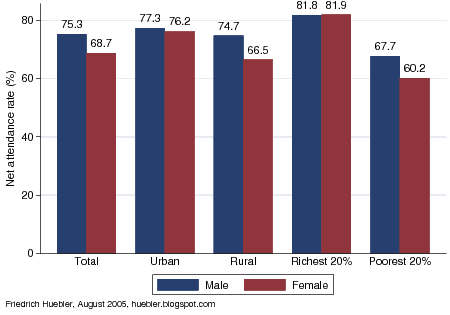Education statistics published by UNESCO are mostly based on administrative records of enrollment. Data from household surveys are an alternative source of statistics on school attendance. Because household surveys collect data on various characteristics of children and the households they live in it is possible to analyze gender disparity in more detail than with national enrollment data on primary or secondary education.
With household survey data a child is counted as being in school if one of the following two conditions is met:
- The child attended school during the week preceding the survey.
- The child was in school anytime during the year preceding the survey. This condition is added to account for children who were not in school because they were ill, because they were on vacation, or for other reasons.
Primary school net attendance rate, India 2000

Data source: India 2000 MICS.
In the country as a whole, more boys than girls go to primary school. The NAR of boys is 6.6% higher than the NAR of girls (see the table below). This gender disparity at the country level is clearly driven by the patterns of school attendance in rural areas and in poor households. In urban areas and among the richest 20% of the population, boys' and girls' attendance rates are virtually identical. Rural families and those from the poorest 20% of the population, on the other hand, are likely to send only boys to school when they cannot afford education for all their children. To reach the Millennium Development Goal of gender parity, policy makers have to focus their efforts on rural India and on households that suffer from poverty.
Primary school net attendance rate, India 2000
| Total NAR (%) | Male NAR (%) | Female NAR (%) | Difference male- female | GPI female/ male | |
| Urban | 76.8 | 77.3 | 76.2 | 1.1 | 0.99 |
| Rural | 70.7 | 74.7 | 66.5 | 8.2 | 0.89 |
| Richest 20% | 81.9 | 81.8 | 81.9 | -0.1 | 1.00 |
| Poorest 20% | 64.0 | 67.7 | 60.2 | 7.5 | 0.89 |
| Total | 72.1 | 75.3 | 68.7 | 6.6 | 0.91 |
Friedrich Huebler, 29 August 2005 (edited 27 January 2007), Creative Commons License.
This is great blog! I'll keep coming back.
ReplyDelete